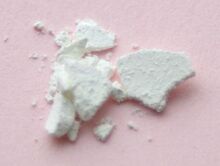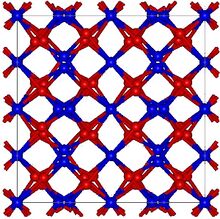Chemistry:Dysprosium(III) oxide
From HandWiki

| |

| |
| Identifiers | |
|---|---|
3D model (JSmol)
|
|
| ChemSpider | |
PubChem CID
|
|
| UNII | |
| |
| |
| Properties | |
| Dy2O3 | |
| Molar mass | 372.998 g/mol |
| Appearance | pastel yellowish-greenish powder. |
| Density | 7.80 g/cm3 |
| Melting point | 2,408 °C (4,366 °F; 2,681 K)[1] |
| Negligible | |
| +89,600·10−6 cm3/mol | |
| Structure | |
| Cubic, cI80 | |
| Ia3, No. 206[2] | |
| Hazards | |
| Main hazards | Non-Toxic |
| Safety data sheet | External MSDS |
| Related compounds | |
Other anions
|
Dysprosium(III) chloride |
Other cations
|
Terbium(III) oxide, Holmium(III) oxide |
Except where otherwise noted, data are given for materials in their standard state (at 25 °C [77 °F], 100 kPa). | |
| Infobox references | |
Dysprosium oxide (Dy2O3) is a sesquioxide compound of the rare earth metal dysprosium. It is a pastel yellowish-greenish, slightly hygroscopic powder having specialized uses in ceramics, glass, phosphors, lasers, as a Faraday rotator[3] and dysprosium metal halide lamps.
It can react with acids to produce the corresponding dysprosium(III) salts:
- Dy2O3 + 6 HCl → 2 DyCl3 + 3 H2O
References
- ↑ Webelements Dysprosium trioxide
- ↑ Curzon A.E., Chlebek H.G. (1973). "The observation of face centred cubic Gd, Tb, Dy, Ho, Er and Tm in the form of thin films and their oxidation". J. Phys. F 3 (1): 1–5. doi:10.1088/0305-4608/3/1/009. Bibcode: 1973JPhF....3....1C.
- ↑ Vojna, David; Slezák, Ondřej; Yasuhara, Ryo; Furuse, Hiroaki; Lucianetti, Antonio; Mocek, Tomáš (2020). "Faraday Rotation of Dy2O3, CeF3 and Y3Fe5O12 at the Mid-Infrared Wavelengths". Materials 13 (23): 5324. doi:10.3390/ma13235324. PMID 33255447. Bibcode: 2020Mate...13.5324V.
 |

